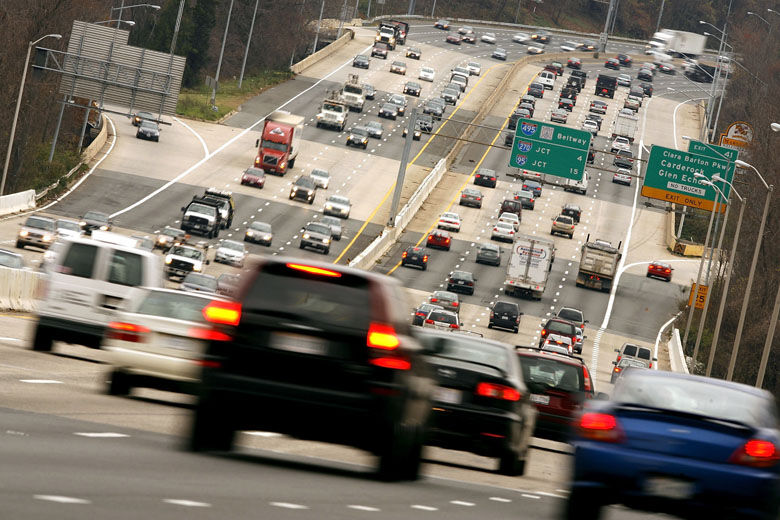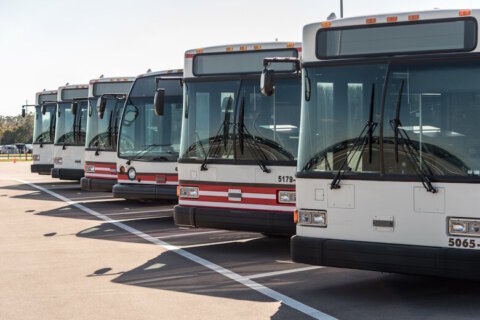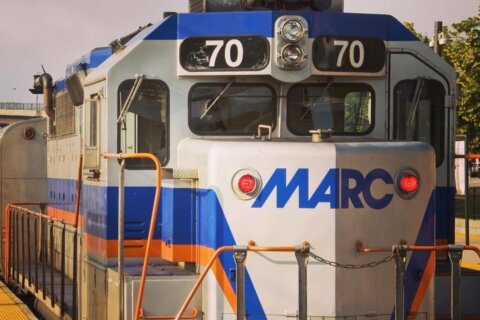This article was republished with permission from WTOP’s news partners at Maryland Matters. Sign up for Maryland Matters’ free email subscription today.

This content was republished with permission from WTOP’s news partners at Maryland Matters. Sign up for Maryland Matters’ free email subscription today.
One of the private-sector groups that expressed initial interest in the Hogan administration’s plan to widen two Washington, D.C.-area highways has dropped out of the bidding, the state Department of Transportation confirmed on Friday.
Potomac Mobility Group, one of four consortiums rated “qualified” by the state last year, declined to submit a bid.
Reports of the group’s decision not to pursue the $11 billion widening of Interstates 495 and 270 surfaced two weeks ago, but a spokesperson for the firm refused to comment. The Department of Transportation also declined to comment, even though it was aware of Potomac’s withdrawal on Dec. 23, the day bid submissions were due.
The consortium was led by a Spanish firm, ACS Infrastructure Development. Dragados USA was their lead contractor. Parsons Transportation Group, Jacobs Engineering Group, and HDR Engineering were the other firms in the consortium.
“As a matter of policy, we do not comment on projects while they are still in procurement,” spokesman Steve DeWitt wrote in a Dec. 26 email.
Potomac’s withdrawal leaves the state with three bidders for the high-profile public-private partnership (P3) project:
- Accelerate MarylandExpress Partners, led by Itinera Infrastructure & Concessions and Halmar International
- Accelerate Maryland Partners, led by Transurban, Macquarie Infrastructure Developments and Archer Western Construction
- Capital Express Mobility Partners, led by Cintra Global, Meridiam Capital Express, John Laing Investments Limited and Ferrovial Agroman U.S. Corp.
In a statement, MDOT said the submission of multiple “very competitive proposals” represented a “major step forward” for the project.
“We received three strong proposals from private investors that want to partner with us to provide new travel options and business opportunities for all Marylanders — bicyclists, pedestrians, buses and carpoolers and truckers,” said Transportation Secretary Greg Slater.
“This level of competition gives us the ability to choose the right partner, who can collaborate with us and key stakeholders in the community to deliver the highest value and most innovative design ideas for improved travel options, reduced environmental impacts, new transit connections and direct bike and pedestrian access across a new American Legion Bridge.”
Gov. Hogan unveiled his plan to build “express toll lanes” on the Capital Beltway and I-270 in 2017 — and the MDOT is pushing to advance the proposal as quickly as it can to bring relief to commuters in Montgomery County, some of whom face traffic delays that are among the nation’s worst.
The term-limited governor leaves office in January 2023.
The project, which now includes the replacement of the American Legion Bridge, is controversial. Critics have said it will harm the environment and lead to tolls that low-income motorists cannot afford. Opponents have accused the state of rushing the project and failing to be transparent.
MDOT has been studying multiple designs and expects to choose one by February. It also expects to chose a winning consortium to build and manage the project from among the firms that submitted bids in the next few weeks.
The greater the number of firms vying for the project, the more leverage the state has to get the best deal.
Last month, MDOT disclosed that it is breaking Phase 1 into smaller pieces, in part to speed the approval process.
Under the state’s new timetable, “Phase 1 South A” would include the bridge, the portion of the Beltway that connects the span to the I-270 west spur, and the inner loop of I-495 between the spur and Old Georgetown Road.
“Phase 1 South B” would result in the widening of I-270 from the spur to Interstate 370. Other portions — including the northern portion of I-270 and the Beltway to Prince George’s — would fall to the next administration.
The P3 industry has been shaken by the COVID-19 pandemic, which has led to a dramatic increase in telework. The decrease in traffic volumes has reduced revenue on existing toll roads, such as those Transurban built and operates in Northern Virginia. The demise of the Purple Line has diminished the allure of private-financed megaprojects as well.
Maryland’s decision to break its project into small pieces may have led Potomac Mobility Group to withdraw from consideration.
“The changes the department made in the latter stages of development of the [Request for Proposals] have significantly changed the financial considerations of bidders,” said a person with ties to the industry.
The person, who spoke on condition of anonymity to speak candidly, said that because some portions of the project will generate more revenue than others, the element of risk goes up when the pieces shrink.
“Before, one vendor would have control of multiple segments so that you can take the risk of having an off-peak segment, or something that wasn’t necessarily as lucrative. You could use your higher-traffic segments to subsidize that. Now the state has changed how that works.”








